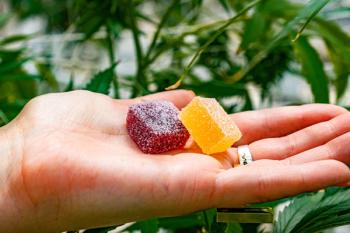
Cannabis Science and Technology
- May/June 2025
- Volume 8
- Issue 3
- Pages: 10-15
From Lab Coat to Chef’s Coat: What it Takes to Make High Quality Cannabis Edibles
There is a great deal of innovation happening in the cannabis edibles space as formulators overcome challenges in taste and texture to make delicious creations that offer a high quality user experience.
Cannabis edibles are growing in popularity in legal cannabis markets due to their ease of use. Products like cookies or chocolate bars, for example, can be easily divided up for optimal dosage and titration. An April 2025 Research and Markets report (1) called “Cannabis Edibles Market Opportunity, Growth Drivers, Industry Trend Analysis, and Forecast 2025-2034”, showed that in 2024, the cannabis edibles market was estimated to be valued at $12.3 billion. By 2034, the edibles industry is anticipated to reach $54 billion and have a compound annual growth rate (CAGR) of 15.9%. The increase in revenue is the result of product innovations, evolving preferences of consumers, and updated regulations (1).
Creating the Edible
Manufacturing cannabis edibles can be a challenge. “There's many, many, many critical factors that we focus on. One of them is obtaining optimal homogenization,” says Jaelynn Accola, Public Relations & Events Coordinator for Mother Earth Wellness Dispensary, which is a vertically integrated retailer that cultivates, extracts, and distills its own cannabis, as well as manufacturers its own edibles in a commercial kitchen.
A key factor in achieving homogenization in cannabis edibles is fat solubility. Tetrahydrocannabinol (THC) is fat soluble and needs to bind to another fat inside the product to aid in full homogenization. In chocolate, for example, full homogenization is possible with the proper cocoa butter and infused coconut oil ratio before being added back into the chocolate base. In the case of gummies, because they are water-based, homogenization is more challenging, but possible if THC is placed into the batch at a similar temperature.
Perfecting the Final Product: Taste and Texture
Cannabis edibles are available in a wealth of flavors and formulations. Part of the challenges of creating edibles is masking or toning down the natural flavor of the cannabis. Of course, different forms of extraction impart different flavors. “Whether you're going to go with a kief, a solventless rosin, a distillate, or what we use in-house, a full spectrum RSO, the different cannabinoid oils have different flavor profiles, as well as effect,” explains Accola. “The kief and the solventless rosin have very strong, what we call ‘green' flavoring. It’s kind of more of a bitter cannabis flavor. [They] also have chlorophyll in them. Chlorophyll gives you that bitter kale sort of flavor versus the distillate,” says Accola.
Different forms of extraction also provide distinct entourage effects. With a full spectrum RSO, for example, there are more cannabinoids compared to a broad-spectrum product. The RSO also imparts that “green” flavor.
“Every manufacturer chooses [flavor profiles] differently based on the product, and the green flavor can be hard to mask in certain food products,” says Accola. “So, say the gummies are super potent, [we use a] strong, sour, blue raspberry flavor. It might mask it a little bit. But say you're infusing a super mild white chocolate; you're going to get all that green flavor. It really is just about catering to the type [of product] that you are making, and what you as a manufacturer feels [works] best.”
Rising up in the ranks of popular dosing formats is nano emulsion. Through this process, formulators are able to expand into the water-soluble area of food products such as beverages. This sector is seeing an increase in popularity as alcohol consumption has been decreasing and consumers may be turning to alternatives like cannabinoids for feelings of euphoria or intoxication (2). The downside of nano emulsion technology is that the machinery required to make these beverage products is expensive and the cost of production with canning machines adds up quickly.
Dosing
For beginner users, experts recommend to “start low and go slow”. This concept refers to the term microdosing which is when you consume in smaller quantities such as 5 mg or lower. Unlike vapes or cannabis flower, which go through the lungs and can be absorbed into the bloodstream, edibles are processed in the stomach and liver where they’ll be metabolized and digested (3). Due to this variable, it can take longer for users to feel the effects of edibles, but can also have longer-lasting and more potent effects versus their vaped or smoked counterparts (3).
With edibles, it’s much easier for beginners to microdose and titrate to higher doses if they so choose. The ability to cut edible products into smaller portions helps with this endeavor and allows for a more pleasant experience. Essentially, edibles allow users to better understand how a given product affects them, as everyone’s tolerance is not the same. These impacts will also vary depending on the cannabinoid composition of the product.
The Canadian Centre on Substance Use and Addiction reported that ingesting cannabis or vaping may be less harmful to your lungs than smoking flower which could explain why edibles are seeing a rise in popularity amongst consumers (4).
Some consumers may need to consume high amounts of THC to obtain the desired effects because their livers don’t produce enough of the enzymes required to metabolize THC. According to Accola, for these consumers, gummies, and other edible formats like chocolates may not be the best option, because they would have to consume thousands of calories to get the desired effects. Therefore, formats like capsules may be better when high doses are required.
Overall, explained Accola, it’s recommended that people eat something fatty before taking a cannabis edible to help the liver better metabolize THC.
Top Cannabinoid Performers
The most popular cannabinoids are THC and cannabidiol (CBD). As the science behind cannabis develops, benefits are being found in other less common cannabinoids. At Mother Earth Wellness, Accola is seeing cannabinol (CBN), cannabigerol (CBG), and cannabichromene (CBC) as cannabinoids seeing growing interest from consumers. Accola highlighted CBN in particular, “[Consumers are] always having difficulty sleeping. The sleep gummy is our most popular gummy across the board.”
Regulatory Challenges
Given that cannabis is not federally legal, edibles are not regulated by the US Food and Drug Administration (FDA) like other food products. This places extra burden on responsible cannabis edible manufacturers to produce safe and quality products.“We aren't regulated by any food safety guidelines, but we are self-regulating inside our facility, and that also has a huge impact on food safety and shelf stability,” Accola explains. It’s important to have people who are experienced in food manufacturing and safety to protect consumers from potential pathogens and protect the integrity of one’s products.
Conclusion
The intricacies of edible creation can be intense and overwhelming. Determining the proper fat/THC ratio needed and getting the taste and texture right can make or break the product, but it is a creative process that produces innovative products capable of making cannabis more palatable and accepted by a broader audience.
References
- Cannabis Edibles Opportunity Analysis Report 2025: Market to more than quadruple to $54 billion by 2034, driven by shifting consumer preferences, evolving regulations, and product innovations - researchandmarkets.com
https://www.businesswire.com/news/home/20250423877953/en/Cannabis-Edibles-Opportunity-Analysis-Report-2025-Market-to-More-than-Quadruple-to-%2454-Billion-by-2034-Driven-by-Shifting-Consumer-Preferences-Evolving-Regulations-and-Product-Innovations---ResearchAndMarkets.com (accessed Jun 9, 2025). - McEvoy, E. Survey asks: Is cannabis or alcohol more harmful?
https://www.cannabissciencetech.com/view/survey-asks-is-cannabis-or-alcohol-more-harmful- (accessed Jun 10, 2025). - Edibles 101: How to consume edibles, benefits, effects, & more
https://www.leafly.com/learn/consume/edibles#how-do-edibles-work (accessed Jun 10, 2025). https://www.ccsa.ca/sites/default/files/2019-06/CCSA-Cannabis-Inhaling-Ingesting-Risks-Infographic-2019-en_1.pdf (accessed Jun 12, 2025).
How to Cite This Article
Colli, M., From Lab Coat to Chef’s Coat: What it Takes to Make High Quality Cannabis Edibles, Cannabis Science and Technology, 2025, 8(3), 10-15.
Articles in this issue
Newsletter
Unlock the latest breakthroughs in cannabis science—subscribe now to get expert insights, research, and industry updates delivered to your inbox.





